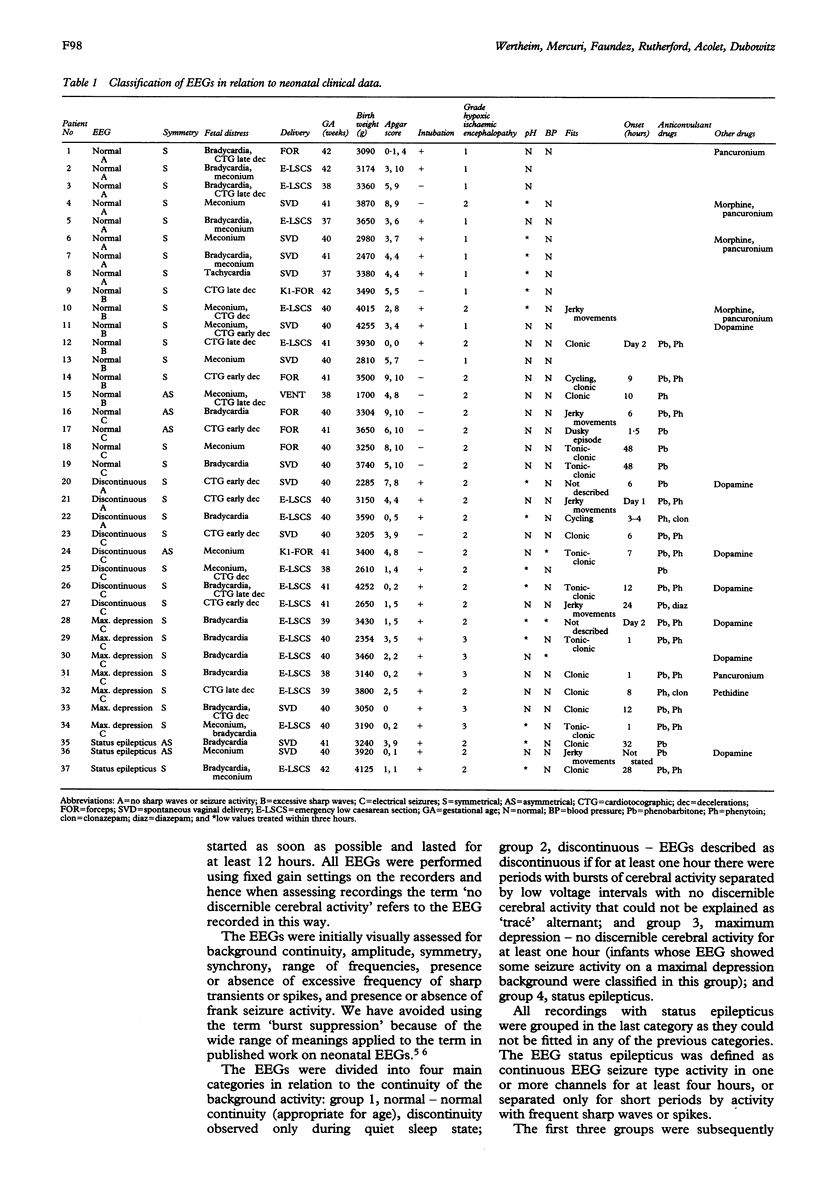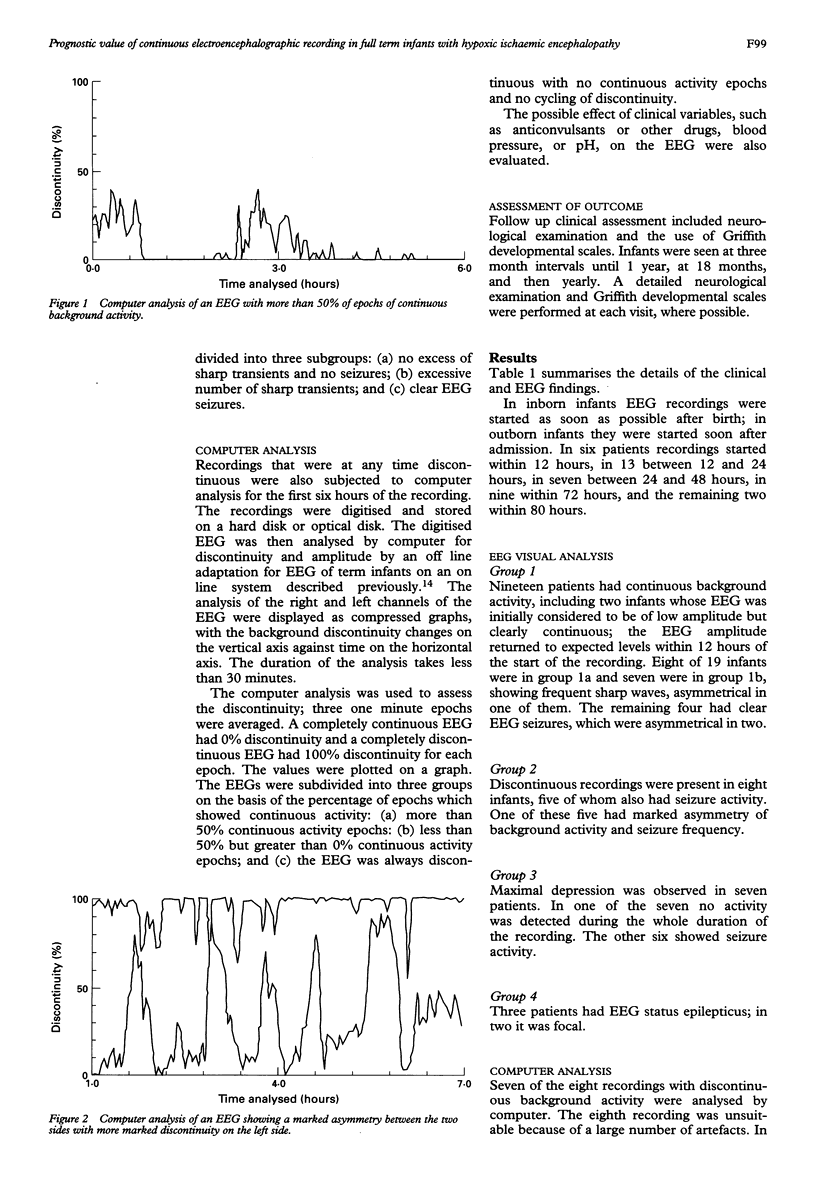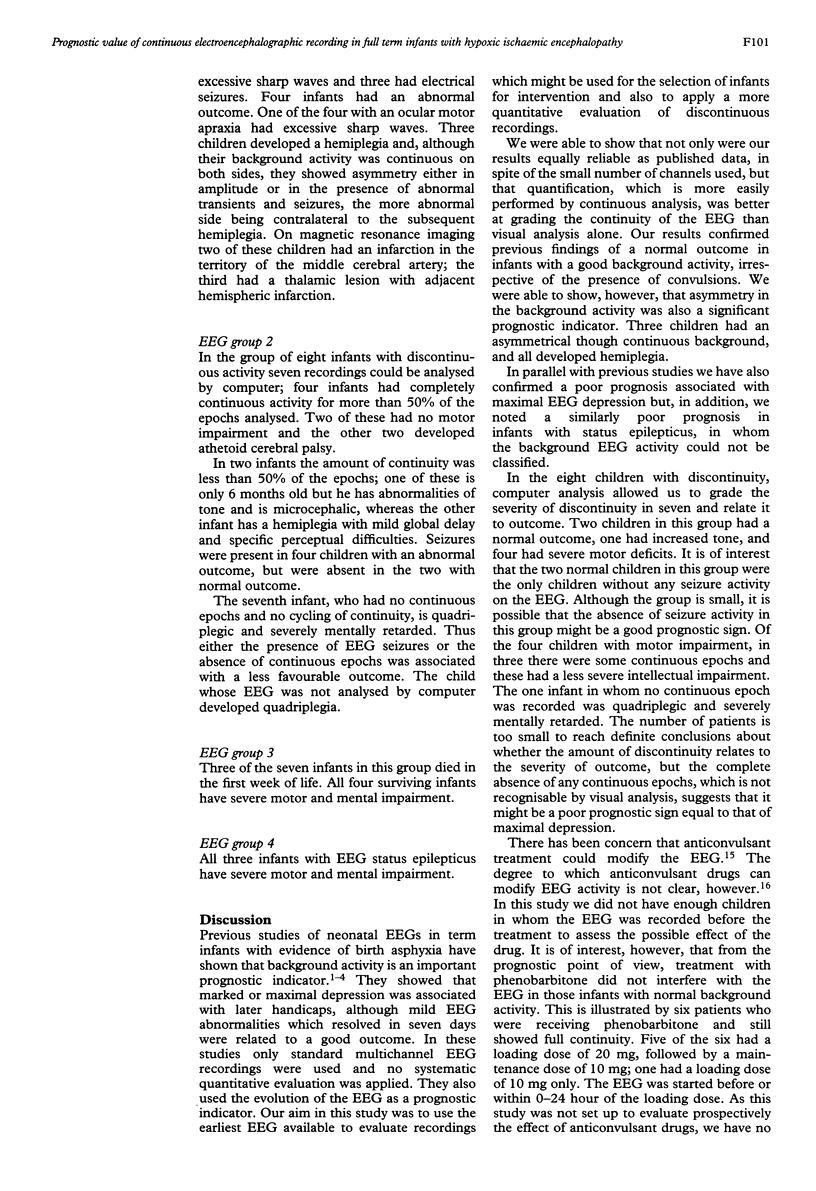Abstract
The prognostic value of early neonatal continuous electroencephalographic recordings in hypoxic ischaemic encephalopathy was evaluated. Thirty seven full term infants with hypoxic ischaemic encephalopathy were studied. The electroencephalogram (EEG) was recorded using four or eight channel Oxford Medilog recorders and was started as soon as possible after birth. The recordings were initially visually analysed and divided into four categories: three in relation to the grade of discontinuity of the background activity (continuous, discontinuous, and maximum depression) and an additional fourth category to include status epilepticus.
The EEGs with discontinuous activity were then analysed by computer to obtain a more objective assessment of discontinuity. The results were related to neurological outcome. Continuous background activity was associated with a normal outcome in all but the three infants who had continuous, but asymmetrical EEGs and who developed contralateral hemiplegia. In the eight infants with discontinuous activity, the outcome appeared to be related to the grade of continuity and the presence of clear convulsions on the EEG. The 10 infants with maximum depression and status epilepticus had severe impairment.
These preliminary results suggest that continuous recording of EEGs could be used routinely in term infants with hypoxic ischaemic encephalopathy. Computer analysis can improve the value of this technique, allowing the identification of infants who might benefit from early therapeutic intervention.
Full text
PDF





Selected References
These references are in PubMed. This may not be the complete list of references from this article.
- Bell A. H., Greisen G., Pryds O. Comparison of the effects of phenobarbitone and morphine administration on EEG activity in preterm babies. Acta Paediatr. 1993 Jan;82(1):35–39. doi: 10.1111/j.1651-2227.1993.tb12511.x. [DOI] [PubMed] [Google Scholar]
- Bjerre I., Hellström-Westas L., Rosén I., Svenningsen N. Monitoring of cerebral function after severe asphyxia in infancy. Arch Dis Child. 1983 Dec;58(12):997–1002. doi: 10.1136/adc.58.12.997. [DOI] [PMC free article] [PubMed] [Google Scholar]
- Connell J. A., Oozeer R., Dubowitz V. Continuous 4-channel EEG monitoring: a guide to interpretation, with normal values, in preterm infants. Neuropediatrics. 1987 Aug;18(3):138–145. doi: 10.1055/s-2008-1052466. [DOI] [PubMed] [Google Scholar]
- Eaton D. G., Wertheim D., Oozeer R., Royston P., Dubowitz L., Dubowitz V. The effect of pethidine on the neonatal EEG. Dev Med Child Neurol. 1992 Feb;34(2):155–163. doi: 10.1111/j.1469-8749.1992.tb14982.x. [DOI] [PubMed] [Google Scholar]
- Eyre J. A., Oozeer R. C., Wilkinson A. R. Diagnosis of neonatal seizure by continuous recording and rapid analysis of the electroencephalogram. Arch Dis Child. 1983 Oct;58(10):785–790. doi: 10.1136/adc.58.10.785. [DOI] [PMC free article] [PubMed] [Google Scholar]
- Greisen G., Pryds O., Rosén I., Lou H. Poor reversibility of EEG abnormality in hypotensive, preterm neonates. Acta Paediatr Scand. 1988 Nov;77(6):785–790. doi: 10.1111/j.1651-2227.1988.tb10756.x. [DOI] [PubMed] [Google Scholar]
- Grigg-Damberger M. M., Coker S. B., Halsey C. L., Anderson C. L. Neonatal burst suppression: its developmental significance. Pediatr Neurol. 1989 Mar-Apr;5(2):84–92. doi: 10.1016/0887-8994(89)90032-5. [DOI] [PubMed] [Google Scholar]
- Holmes G., Rowe J., Hafford J., Schmidt R., Testa M., Zimmerman A. Prognostic value of the electroencephalogram in neonatal asphyxia. Electroencephalogr Clin Neurophysiol. 1982 Jan;53(1):60–72. doi: 10.1016/0013-4694(82)90106-7. [DOI] [PubMed] [Google Scholar]
- Moussalli-Salefranque F., Mises J., Plouin P. Significations du tracé discontinu chez le nouveau-né à terme. Rev Electroencephalogr Neurophysiol Clin. 1983 Dec;13(3):240–244. doi: 10.1016/s0370-4475(83)80034-3. [DOI] [PubMed] [Google Scholar]
- Pezzani C., Radvanyi-Bouvet M. F., Relier J. P., Monod N. Neonatal electroencephalography during the first twenty-four hours of life in full-term newborn infants. Neuropediatrics. 1986 Feb;17(1):11–18. doi: 10.1055/s-2008-1052492. [DOI] [PubMed] [Google Scholar]
- Sarnat H. B., Sarnat M. S. Neonatal encephalopathy following fetal distress. A clinical and electroencephalographic study. Arch Neurol. 1976 Oct;33(10):696–705. doi: 10.1001/archneur.1976.00500100030012. [DOI] [PubMed] [Google Scholar]
- Staudt F., Scholl M. L., Coen R. W., Bickford R. B. Phenobarbital therapy in neonatal seizures and the prognostic value of the EEG. Neuropediatrics. 1982 Feb;13(1):24–33. doi: 10.1055/s-2008-1059591. [DOI] [PubMed] [Google Scholar]
- Takeuchi T., Watanabe K. The EEG evolution and neurological prognosis of neonates with perinatal hypoxia [corrected]. Brain Dev. 1989;11(2):115–120. doi: 10.1016/s0387-7604(89)80079-8. [DOI] [PubMed] [Google Scholar]
- Watanabe K., Miyazaki S., Hara K., Hakamada S. Behavioral state cycles, background EEGs and prognosis of newborns with perinatal hypoxia. Electroencephalogr Clin Neurophysiol. 1980 Sep;49(5-6):618–625. doi: 10.1016/0013-4694(80)90402-2. [DOI] [PubMed] [Google Scholar]
- Wertheim D. F., Murdoch Eaton D. G., Oozeer R. C., Connell J. A., Dubowitz L. M., Dubowitz V., Willetts R., Wootton R. A new system for cotside display and analysis of the preterm neonatal electroencephalogram. Dev Med Child Neurol. 1991 Dec;33(12):1080–1086. doi: 10.1111/j.1469-8749.1991.tb14830.x. [DOI] [PubMed] [Google Scholar]


